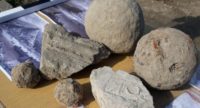 Archaeologists excavating the Zishtova Fortress in Svishtov, Bulgaria, have unearthed cannonballs likely used by Wallacian Voivode Vlad III Dracula, aka Vlas Tepes, aka Vlad the Impaler, during his assault on the fortress in 1461. The balls were shot from culverins, early cannons that evolved from hand-held weapons (ancestors of the musket) to field artillery. They were in use just up to the beginning of the 16th century. The balls were discovered in the layer dating to the 15th-16th century.
Archaeologists excavating the Zishtova Fortress in Svishtov, Bulgaria, have unearthed cannonballs likely used by Wallacian Voivode Vlad III Dracula, aka Vlas Tepes, aka Vlad the Impaler, during his assault on the fortress in 1461. The balls were shot from culverins, early cannons that evolved from hand-held weapons (ancestors of the musket) to field artillery. They were in use just up to the beginning of the 16th century. The balls were discovered in the layer dating to the 15th-16th century.
“What’s really interesting is that from the [early] Ottoman period we have found cannonballs. We rejoice at those small cannonballs because they are from culverins. These were the earliest cannons which were for the 15th century, up until the 16th century, they weren’t in use after that. These were still very imperfect cannons. That was precisely the time of Vlad Dracula, there is no doubt that they are connected with the siege [and conquest of the Zishtova Fortress] by Vlad Dracula in 1461,” [Prof. Nikolay Ovcharov from the National Institute and Museum of Archaeology in Sofia] says.
The fortress is on a hill in the center of the town. It dates to the 13th-14th century, but the hill’s strategic location with clear views to the east, west and north has ensured its constant occupation since the Romans built the first fortress there in the 4th century. In 1389 it was besieged by the Ottoman forces of Sultan Murad I commanded by Grand Vizier Çandarlızade Ali Pasha, only falling when the last of its supplies ran out. Pasha’s campaign forced Bulgarian tsar Ivan Shisman to surrender to the Ottoman Turks and while fighting would continue in some areas for another five years, Bulgaria would remain largely under Ottoman control from that point until the Russo-Turkish War of 1877-78.
Ottoman chronicles record Vlad Dracula’s capture of Zishtova Fortress, and in a letter Vlad wrote to the King of Hungary Matthias Corvinus in February of 1462 he boasts of having killed 410 Turks during the siege. It seems he lived in the fortress for a few months that winter as well.
The fortress didn’t make it the Liberation of Bulgaria in 1878. It was partially destroyed during the Russo-Turkish war of 1806-1812 after the surrender of the Ottoman garrison. Russian General Kamensky ordered it burned down so that the Turks could never reoccupy it. Sturdily built, the fortress held up quite well to the fire. Significant parts of it were still standing until 1850 when the stones were pillaged to build a new barracks for the Turkish army.
Even so, the ruins of the fortress are in better shape than you might think. Professor Ovcharov notes that Zishtova Fortress has high sections of wall still standing making one of the best preserved in Bulgaria.